
Monark 1925 (1913, 1920-25)-c1978 Sweden
Confusion, confusion! Varberg firm who, for the greater part of their motorcycle making life, traded as AB Cykelfabriken Monark. They had two attempts at becoming motorcycle makers before establishing the Monark brand in 1925 to become one of Sweden’s leading motorcycle makers. They first experimented with motorcycle design in 1913, but waited until 1920 before producing a single speed, pedal-start 172cc two-stroke lightweight marketed as the Esse (Essc). It wasn’t a big seller.
In 1925, they launched a range of four-stroke single cylinder machines, which over the next decade, comprised 250-600cc ohv and side-valve designs – tough machines built for Sweden’s rugged roads. Monark sales grew as did their reputation. In 1936, they formed a liaison with German proprietary two-stroke engine makers Ilo, units around which they began to centre their range, dropping many of the four-stroke designs.
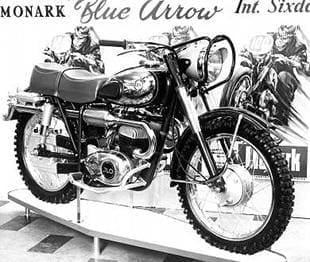 As WWII approached, Ilo engine supply ended, leading Monark to adopt Husqvarna designed, Albin built units, including the 495cc OHV single which powered their successful m/42 military model launched in 1942. Over 3000 were built, some remaining in service until 1965 and there were a few side-valve models too. After the war Monark returned to building tough predominantly two-stroke 48-249cc lightweights, sourcing engines variously from Ilo, Adler, BSA (Bantam D1), CZ and Swedish JB.
As WWII approached, Ilo engine supply ended, leading Monark to adopt Husqvarna designed, Albin built units, including the 495cc OHV single which powered their successful m/42 military model launched in 1942. Over 3000 were built, some remaining in service until 1965 and there were a few side-valve models too. After the war Monark returned to building tough predominantly two-stroke 48-249cc lightweights, sourcing engines variously from Ilo, Adler, BSA (Bantam D1), CZ and Swedish JB.
Monark focused more and more on off-road and competition machinery, although they still built superb roadsters including the Blue Fighter, which was launched in 150cc form with an Ilo engine in 1952. Later came a 250cc twin cylinder version. The Blue Fighter remained in production until the Sixties. Then in the early Seventies, came the TS and TTS models with Sachs engines and Ceriani front fork.
From the late-Forties, Monark began to enjoy national competition acclaim but in 1954 came their first major International success as a team of 250cc Blue Arrows – derived from the Blue Fighter – took the Swedish team to gold medals in the ISDT held in Wales. For seven seasons (1957-63) Monark excelled in the Moto-Cross World 500cc Championship series, with third place in 1957 and 1958 and a win for Sten Lundin in 1959. Lundin won the title again in 1961 riding a Lito (marque comprising highly modified BSA or Husqvarna-Albin-engines mounted in predominantly Monark rolling chassis) followed by fourth places for Ove Lundell (1962) and Per-Olaf Persson (1963) again riding Monarks.
In 1960, Monark took over Nymans Verkstader who were responsible for the NV and Nymans marques and also Crescent and Apollo. The new firm was restructured as Monark Crescent Bolagen-MCB. They launched a range of 50cc motorcycles aimed at schoolboy scramblers with either Morini or Sachs engines. In 1971 they began developing road race machines including the machine which took Lars Persson to the 50cc Swedish Championship, a 500cc racer with a boat derived engine and later a 125.
 Monark continued building off-road models into the Seventies including a 123cc Sachs-engined ISDT replica and, in a final fling, Monark unveiled a superbly built 175cc Enduro model in 1976 with a 171cc Sachs unit. Sales of these beautifully crafted motorcycles fell, leading the factory to end production and concentrate on other business.
Monark continued building off-road models into the Seventies including a 123cc Sachs-engined ISDT replica and, in a final fling, Monark unveiled a superbly built 175cc Enduro model in 1976 with a 171cc Sachs unit. Sales of these beautifully crafted motorcycles fell, leading the factory to end production and concentrate on other business.
Although one of Sweden’s leading factories, Monark exported few motorcycles. Overseas dealers who could see a ready market, especially for the off-road competition models, found they were treated in a casual manor by this close knit factory, who wanted to build the best they could for the home market, but weren’t interested in export sales. Although rare outside Sweden, ownership of many Monarks – which often featured yellow bodywork – isn’t too daunting as they are built mainly from proprietary parts.
Mondial 1948-c1969 Italy
Like Aermacchi, Fratelli Boselli (FB) – the Boselli Brothers-made light industrial and delivery trucks in their Bologna factory. After WWII, Count Giuseppe Boselli – a successful competitive motorcyclist in the Thirties, reasoned it would be brilliant publicity for the family truck business to establish a world beating motorcycle race team. What followed was one of the most dramatic entrances to the world GP circus ever.
The Count established a factory in Milan to make his miniature racers and installed veteran designer Alfonso Druisiani. The resultant 124cc, dohc single, with exposed hairpin valve springs, external flywheel, Dell’Orto carburettor and magneto ignition was easily 10mph faster than its two-stroke rivals from MV, Morini and Eysink. After a few national outings in 1948, FB Mondial won every 125cc GP with World Championships for Nello Pagani, Bruno Ruffo and Carlo Ubbiali including a 1951 IoM TT win for Ireland’s Cromie McCandless.
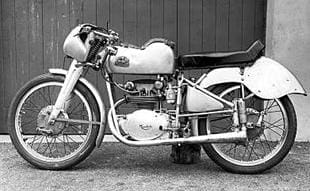 Spurred on by their phenomenal racing success, Mondial began production of roadsters in 1950. A range of 50-250cc two and four-stroke models evolved over the next few seasons and the sporting ohv/sohc 125 and 175cc singles led Mondial to manufacture ‘over the counter’ racers in these capacities. But with this work in progress development of the works racers slowed and after Carlo Ubbiali’s second place in the 1952 125cc World Championship, Mondial temporarily withdrew from racing.
Spurred on by their phenomenal racing success, Mondial began production of roadsters in 1950. A range of 50-250cc two and four-stroke models evolved over the next few seasons and the sporting ohv/sohc 125 and 175cc singles led Mondial to manufacture ‘over the counter’ racers in these capacities. But with this work in progress development of the works racers slowed and after Carlo Ubbiali’s second place in the 1952 125cc World Championship, Mondial temporarily withdrew from racing.
Privateers continued to campaign the marque with some success. Drusiani redesigned the 125cc racer and, in 1955, Tarquinio Provini joined the works team. Forays into the 250cc class were planned too, first with an overbored 125 of 216cc, then with a pukka 247cc twin cylinder racer, which unfortunately was grossly overweight and ineffectual. In late 1956, Drusiani came up with another new 125, which was scaled up to give the 249cc dohc single. In 1957, Provini won the 125cc title chase with fellow works rider Sammy Miller fourth and the company completed the one, two, three in the 250cc class, after which the company again retired from racing.
Works 125cc dohc Mondial single prepared for 1953 IOM lightweight TT. Mondial twice attempted to enter the scooter market and both efforts were oddities. The first, in 1952, was a 125cc model comprising a tubular steel frame and bodywork which enclosed everything except the engine and the second – the Lady, a 75cc two-stroke scooter – appeared in 1959 and bore more than a passing resemblance to the Capri. Production of pleasant lightweight roadsters continued until 1979 with some of the later models being fitted with Sachs rather than Mondial engines.
Recent attempts have been made to revive the name. In the Sixties, the company returned to racing at a low key level with Francesco Villa designed two-strokes and the Italian Isnardi won the company’s last world championship points in 1972. The factory sold many of their works racers after they’d finished active service so they occasionally crop up for sale, but don’t expect bargains! Mondial lightweight roadsters of many types are surfacing in Italy.
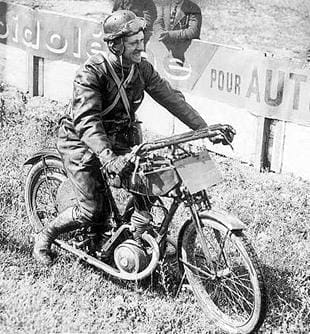 Monet-Goyon 1917-59 France
Monet-Goyon 1917-59 France
For decades one of France’s leading motorcycle factories who built sturdy basic lightweights, cracking sportsters and well equipped light and medium-weight tourers. Yet this Macon, Saone-et-Loire business was responsible for some pretty bizarre models too, including a delivery-type motorcycle three-wheeler with its forward mounted commercial body replaced by an attractive torpedo sidecar body. Then there was the 98cc Villiers engined Starlett scooter with a substantial pressed steel frame which, like others from motorcycle factories, couldn’t make its mind up if it was a scooter, autocycle or motorcycle.
Production started with a motorised tricycle intended for WWI invalids, comprising a heavyweight adult tricycle with Lloyd-Loom type wicker seat (less legs) and a Wall Auto Wheel engine mounted inboard of the right hand pressed steel rear wheel, which it drove. Later models used a 147cc Villiers engine which was then built into a direct drive scooter-like machine called the Velauto. Then came Villiers-engined motorcycles and the Super-Velauto, 269cc Villiers-engined scooter.
By 1926 Monet-Goyon had added four-strokes to their range using Swiss MAG 246/496cc singles of either ohv or inlet over exhaust design. Following a takeover of the Lyonbased Koehler-Escoffier factory in 1929 they began using KE’s distinctive inclined ohc units and then developed their own 350cc side-valve engine. The range of 147cc two-stroke to 500cc four-strokes models continued through the Thirties, but in 1932 they added a 100cc two-stroke Velomoteur.
From c1935 they built their own Villiers engines under licence from the Wolverhampton factory and also supplied a 486cc side-valve model to the French military which was used for sidecar dispatch and personnel carrier duties, until replaced by the Gnome Rhone AX2. Monet-Goyon continued with Villiers-engined lightweights after WWII along with 350cc side-valve and ohv singles. Scooter production restarted with the Villiers 1F engined Starlett from which evolved the S2, S2L Luxe and Grand-Luxe, all in the style of a scooter/covered motorcycle. In 1956 came the Starlett Record 53R and Eiffel Tower grey Le Dolina which were built as prototypes only. But the advanced, highly styled 122cc Pullman did get into production in 1956. Comprising a fully enclosed Villiers engine suspended from a spine frame with telescopic front fork, monoshock rear suspension and grill enclosure around the rear wheel, it was stylish and different, but not enough to save the Macon firm.
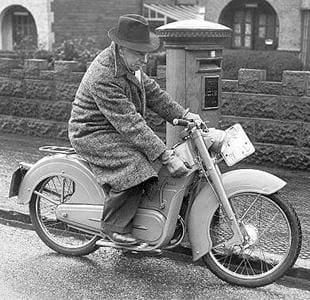 Many Monet-Goyons ooze French style and charm and if you want something a little different you could do far worse than buy a Monet-Goyon, especially as Villiers engine spares for post WWII models abound and pre-WWII parts, along with MAG spares, can be sourced by trawling autojumbles.
Many Monet-Goyons ooze French style and charm and if you want something a little different you could do far worse than buy a Monet-Goyon, especially as Villiers engine spares for post WWII models abound and pre-WWII parts, along with MAG spares, can be sourced by trawling autojumbles.
Monopole 1911-24 UK
Coventry maker who began production with 500cc Precision-engined belt drivers, turning later to other proprietary engines including 269/247cc Villiers and 293/680cc JAP units. Attractive, well made machines which are worth a second look when occasionally on offer.
Montesa 1945- Spain
A former coal truck driver and car mechanic who established a petrol refining business, Pedro Permanyer met motorcycle enthusiast, Spain’s future leading engine designer and later founder of Bultaco, Francisco Bulto, in 1944, beginning a strained business relationship which lasted until 1958. Initially Permanyer wanted to only build proprietary engines, but Bulto wanted to make complete motorcycles. Bulto won the argument leading Montesa to build 22 rigid framed 93cc two-stroke machines in their first year.
Although the pair agreed to each funding 50 per cent of Montesa, soon Bulto reduced his share to 30 per cent due to other business interests. At the time Spain had no real motorcycle industry and, following the Spanish Civil War, had few specialist engineering firms from whom Montesa could source parts. Luckily they were able to buy plant from bankrupt local car makers Eucor and expanded production at their Concega Street, Barcelona premises. Soon, 125s joined the range and, despite restrictions due to the state of the Spanish economy, the production line was soon running 24 hours a day.
Montesa manufacture then transferred to three larger premises in Pampola Street and a work force vote changed the colour of Montesa motorcycles from drab grey to bright red. Bulto only worked for the concern part-time until 1949, as his design skills were in demand by other vehicle makers, but once devoted to Montesa he soon introduced a road race programme and developed off-road motocrossers.
The racers used tuned 125cc engines with bolt-up six speed gearboxes and extreme stuffers within the crankcase and into the lower regions of the piston stroke, to increase crankcase pressure and therefore performance. Raced successfully nationally, their first GP points came in 1952 at the Spanish round at Montjuich Park, Barcelona, as Juan-Soler Bulto finished fifth in the 125cc race behind the mighty Italian works teams of Mondial and Morini. Off the track, Montesa built up a range of 80-125cc Brios which sold well in Spain and to export markets.
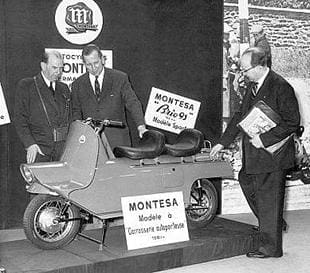 At the 1956 Lightweight 125cc TT, Montesa enjoyed their best race result with Marcello Cama, Francisco Gonzalez and Enrique Sirera finishing second, third and fourth behind Carlo Ubbiali’s MV Agusta. But the expense of racing caused Permanyer, as major shareholder, to curtail the Montesa race programme. An angry Bulto left in 1958, cashing in his 30 per cent holding, taking with him 12 senior Montesa staff and his all new engine design, to set up Bultaco. Somehow, Pedro Permanyer picked up the pieces, and hired Leopold Mila (technical director), Pedro Pi (test rider and development engineer) and his 18-year-old son Javier Permanyer (sports assistant).
At the 1956 Lightweight 125cc TT, Montesa enjoyed their best race result with Marcello Cama, Francisco Gonzalez and Enrique Sirera finishing second, third and fourth behind Carlo Ubbiali’s MV Agusta. But the expense of racing caused Permanyer, as major shareholder, to curtail the Montesa race programme. An angry Bulto left in 1958, cashing in his 30 per cent holding, taking with him 12 senior Montesa staff and his all new engine design, to set up Bultaco. Somehow, Pedro Permanyer picked up the pieces, and hired Leopold Mila (technical director), Pedro Pi (test rider and development engineer) and his 18-year-old son Javier Permanyer (sports assistant).
Mila modernised Montesa to unit construction instead of bolt-up gearbox on the Brio range and unveiled the incredibly quick 175cc Impala roadster in 1962. So successful was the Impala it spawned up to 250cc versions and racing models too. Pi restarted low key in cheaper national racing and developed the motocross programme, became a regular national champion and evolved the 250cc Scorpion in 1965.
Montesa started a trials programme with a model which was developed into a world class machine – the Cota – by former Greeves star Don Smith. Pi took the 1968 Spanish Trials Championship and Don his third European Championship a year later from arch rivals Bultaco and Sammy Miller. By the mid-Seventies the Cota had developed into a range of 50-350cc models suitable for school children up to international riders, and from 1975 a new generation of motocross models from 125-360cc, the Cappra, were on offer.
After a lull of a few years the Impala was re-introduced in the late-Seventies but dwindling sales saw Montesa struggling. Honda took over the company in 1981, largely as a Spanish assembly base for their own models, but fortunately kept on with the Montesa trials programme, leading to the rebirth of Montesa as a world leading off-road competition factory. Montesa tried to break into the lucrative scooter market three times, the first in the late Fifties with a strange device comprising a scooter-like chassis hidden under glass fibre bodywork with two seats on top. In 1962-5 came the Montesa Micro Scooter, in effect their version of a Laverda Mini Scooter with 60cc ohv engine and finally an uprated model, the Micro 66.
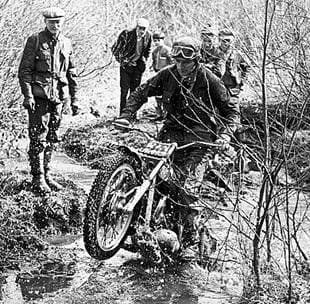 Plenty of Montesa roadsters survive in the barns and backyards of Spain where some spares can be found. Many motocrossers and even more trials Cotas survive, still in regular use around the world serviced by a healthy spares back-up among enthusiastic dealers.
Plenty of Montesa roadsters survive in the barns and backyards of Spain where some spares can be found. Many motocrossers and even more trials Cotas survive, still in regular use around the world serviced by a healthy spares back-up among enthusiastic dealers.
Montgomery 1905-40 UK
Bury St Edmunds firm founded by Bill Montgomery, who by 1900 were making trailers and forecars and then, by 1904, sidecars, the first of which used the Mills and Fulford patented castor wheel. By 1905 Montgomery had begun making 5hp V-twin motorcycles enabling them to offer complete sidecar outfits. Among claims was the ability of the rider to remove the sidecar from the motorcycle in two minutes while other models had flexible mountings enabling the plot to lean into corners.
Around 1909 Bill Montgomery moved his business to Queen Street, Coventry, with the works at Freeth Street. Design improvements included sprung sidecar wheels, child’s sidecars for cycles and coachbuilt bodies replacing wickerwork. Sidecars continued as their main business with motorcycles built from proprietary parts as a sideline to complement sidecar manufacture.
Up to WWI, Montgomery focused on machines for sidecar use with engines from the likes of JAP and Coventry Victor. After the war they built up their motorcycle trade with an extensive range of models using proprietary engines including Villiers, JAP, MAG, Coventry Victor and Anzani from 147cc to 1000cc. In 1925 fire destroyed the works halting production, but Montgomery bounced back with a large range of models for a small scale maker, from new premises in Leicester Causeway, Coventry. Among their component designs was a leaf sprung front fork on Indian style which was bought by rival makers including Coventry Eagle.
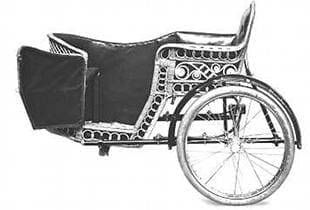 Despite some inventive advertising copy including during the veteran period, a machine fitted with two sidecars, one for your wife and one for the children(!) and later the slogan ‘Double your pleasure,’ sidecar manufacture ended in 1930. During the Thirties selected motorcycles were given dog names: Terrier, Bulldog, Greyhound and Retriever but these didn’t code for one specific model, thus the Greyhound covered models from 250-500cc and Terrier 98-600cc. Also the model names could change from year to year: eg the 250cc ohv Jap engined model was a Greyhound in 1933/34, Terrier 1935/36, Greyhound 1937 then Terrier through to WWII with the Retriever an additional 250cc model in 1938! A bombing attack during early WWII destroyed the Montgomery works and this time they didn’t pick up the pieces.
Despite some inventive advertising copy including during the veteran period, a machine fitted with two sidecars, one for your wife and one for the children(!) and later the slogan ‘Double your pleasure,’ sidecar manufacture ended in 1930. During the Thirties selected motorcycles were given dog names: Terrier, Bulldog, Greyhound and Retriever but these didn’t code for one specific model, thus the Greyhound covered models from 250-500cc and Terrier 98-600cc. Also the model names could change from year to year: eg the 250cc ohv Jap engined model was a Greyhound in 1933/34, Terrier 1935/36, Greyhound 1937 then Terrier through to WWII with the Retriever an additional 250cc model in 1938! A bombing attack during early WWII destroyed the Montgomery works and this time they didn’t pick up the pieces.
Despite some strange model identification policy, their motorcycles were well built and make a good buy for the Vintage and pre-WWII enthusiast who wants something different. Although rare, models do turn up for sale both in the UK and abroad as they were exported to a number of former British Commonwealth countries.



